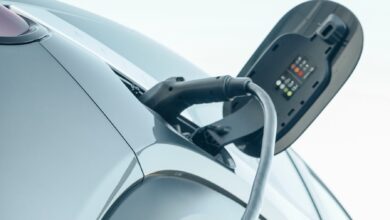EV charging needs more private sector investments: ABB chair

The ISM’s manufacturing Purchasing Managers’ Index (PMI) slipped to 48.7 in May from April’s reading of 49.2, falling short of estimates of 49.5 for the month. Additionally, the ISM also reported that new orders fell to 45.4 and prices paid also fell to 57.0. What does weakening manufacturing data mean for energy companies and the growth of EV charging infrastructure?
ABB (ABBNY, ABBN.SW) Chairman Peter Voser says the company generally “hasn’t seen the slowdown” in electrification and automation, but has noticed a slowdown in the United States’ subsidies and grants attributed to the building of an electric vehicle charging infrastructure.
“That has to be a privately led kind of drive. We are global leader on the charger itself, but we are not building the the infrastructure for that,” Voser tells Catalysts’ Madison Mills in-studio. “But this needs obviously more private money, it needs more investments because I think the electric vehicle side, the demand is there.”
Voser, also the former CEO of Shell (SHEL), weighs in on President Biden’s tariffs against Chinese imports, particularly EVs.
For more expert insight and the latest market action, click here to watch this full episode of Catalysts.
This post was written by Luke Carberry Mogan.
Video Transcript
Now.
Manufacturing data out this week showed weakness in the month of May.
This is the second straight month of slowing manufacturing growth to break down.
What a CEO and executive in the space is seen in the automation and electrification manufacturing space.
We’ve got Peter Voser.
He is a current chairman and he the former shell CEO joining us here in studio.
Peter, thank you so much for being here.
We really appreciate it.
Thanks for having me.
So I want to start on this data that we’re seeing about some potential softness in the manufacturing space.
To what extent are you seeing that in your role at a BB?
What is that looking like for which is concentrating on electrification and automation.
We haven’t seen that slowdown.
We have actually seen a pick up in the short cycle orders, which normally is a good sign that the economy is actually doing much better than anticipated because that has been coming down for a few quarters.
So so far, I think we are still in the camp of its better than expected.
But the second half will have some uncertainty.
So that’s interesting, given that the data has sort of looked worse in terms of that in the first half.
So we’ll have to see in the second half.
But, I, I wanna get to what you’re seeing in the EV space while we have you.
I know the majority of your revenue comes from building new energy systems and you’ve said that the whole electrification network, when it comes to EVs, really needs to be up to speed.
Where do you anticipate that up to speed this coming from?
Do you anticipate the private sector coming in on infrastructure?
Do you think it’ll be company driven at the public sector?
I think it has to be predominantly private and it has to start with the utilities actually providing us with the electricity.
That means the networks needs to be further developed.
The infrastructure and some of the acts there in the US do help if I stay with the US but then also on the more the charging infrastructure.
In my opinion, that has to a privately led kind of drive.
We are a global leader on the charter itself, but we are not building the infrastructure for that.
But this needs obviously more private money.
It needs more investment because I think the electric vehicle side the demand is there.
We see a little bit of a slowdown at the moment because subsidies are going out of the market.
But I think the long term change into the new energy system, which is electrification, is going to happen.
Therefore, we need urgently infrastructure investments, and that should come from utilities and other new players going into that area.
When you hear about a Mercedes a stante pulling back on battery factories because of poor demand, what read through does that have to your business?
Obviously, that could mean less charging for us.
But given that we have a backlog, I wouldn’t see this as actually impacting us a lot because I think the infrastructure normally should be ahead of the usage of the technology of the cars itself.
Over the last few years, this has been the other way around.
You saw a lot of cars coming in and then the electrify America’s game in Europe.
It’s the ion.
It’s really the governments and the private sector now building the infrastructure, and I think therefore this will happen.
I think we are selling a lot of charges at this stage in the industry.
But there has been a slowdown.
There is no doubt about that.
But the long term perspectives are exactly the same, in my opinion.
Very positive.
I want to talk to you about China.
We’ve seen executives like Elon Musk going to China now, saying that he favours no tariffs on Chinese EVs regarding the kind of tariff tit for tat that we might see bubbling up and kind of the tension worsening over that between the US and China.
What impact does that have for you and where would you say you lie?
On the tariffs conversation?
I think there are two answers to this for money in China.
Now I have to tell you that never had global supply chains.
So we sell in a country what we produce in a country that’s the same in the United States or in but in China it’s around 85%.
In Europe, it’s around 95%.
We produce and sell there.
Therefore, the tariffs for us are a little bit less relevant now coming to the US We had this situation also in between 2016 and 20 for example, where tariffs on steel actually were going up.
And as long as we can demonstrate that the steel cannot be produced, for example, in the United States we normally got a favourable response of Washington that these tariffs were not hike that much because at the end it will be the consumer in the US paying it.
So I think let’s see how this will develop but tariffs on the imports of other countries for products you cannot produce in the country.
I think we need to find a different solution than just actually putting tariffs up, because at the end it will be the US consumer paying the bill for that as an executive that works really globally.
Though I am curious what it’s like for you to kind of walk the tight rope between the US and China.
How do you navigate those conversations when we do have this tense backdrop?
I think as a company you have the obligation to look at these risks and therefore we have a plan, a B and C in China.
Should anything happen in Taiwan, should anything happen more on the tech war, we do use different technologies in China for our local for local business.
So we are not using, let’s say, Western technology, so you have to adapt your system in order to actually be able to produce and sell.
We look at this from a macro perspective and then bring it down to micro where we can really manage the countries.
And yes, it’s a concern on the one side.
But on the other side we are paid to also deal with obstacles in the road and that’s what we are doing in terms of planning, risk management, etc.
I love that Take it’s hard but that’s what we are paid for, right?
I want to get your take on one last saying here you’re on the board at IB MA Company.
That’s really successfully navigated the transition to the A. I boom creating a fund for a I start ups, for example What was it like in the room in terms of meeting with the board?
What single decision were you a part of?
That kind of laid the path for that a I transition and adoption at IBM to go so well I’m not the official spokesperson, but I give you an answer.
I think over the last few years under the management and the leadership of our wins.
Obviously, IBM was positioned in a very different way, starting with the major acquisition of Red Hat, which was a cornerstone in the strategy which we are using this spin off, also of of kindred.
And with that actually in the discussions in the board focused on new technologies and a I dominated the last few months.
I think in 23 years time you will see that Quantum will dominate the boardroom as well.
And I think IBM is a B to B business.
It’s not a B to C business, and therefore I think the tremendous opportunity which lies in the industries by using a I. I think IBM is well positioned to actually go in and get their fair market share of this one.
And I think that’s not yet reflected in all the write ups I see on IBM.
Because the B two B business comes after the B two C business, you’re already having discussions about quantum.
Of course we have because that’s a long term strategic emphasis of IBM, and I think, uh, it’s it’s one we all look forward to, all right, Peter.
Well, we’re gonna have to have you joining us to discuss the future of Quantum.
After this, A I boom starts to wrap up.
Thank you for joining us.
Thank you for coming in the studio.
We really appreciate it.
Thank you for having me.
That was Peter Boer.
He is a BB chairman and the former CEO of Shell as well.



